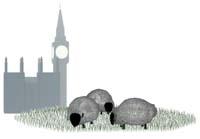Cysteine, sheep
2011/03/01 Roa Zubia, Guillermo - Elhuyar Zientzia Iturria: Elhuyar aldizkaria

To say that London is the main culprit of being a big city is perhaps too much, but it is not a nonsense. There is a strong relationship between the amino acid cysteine and the growth of the English capital. This relationship focuses on the wool and export industry.
England has been a major exporter of wool throughout history (today it also exists) and much of the exported wool came out of the port of London. Therefore, the wool trade meant great wealth for the city, attracted people and contributed to its physical expansion.
Wool, of course, is produced by sheep, but for this a certain molecule is essential. Wool also needs many other molecules, but among them cysteine amino acid is a limiting factor. In the absence of cysteine, sheep do not get hair. Hence the importance of this amino acid in the growth of London.
In history, in general, the English sheep have not suffered large deficiencies of cysteine. For these animals, the main source of cysteine is food, grass. And there is no shortage of grass in England. Farmers who sell wool know perfectly well that when there are droughts there is less grass, and although sheep do not die, wool production decreases much. In England, however, there is usually not much drought and sheep have certified the source of cysteine.
Humans, in fact, in addition to food, get cysteine from our body. Human cells are able to synthesize cysteine; for example, when they do not have enough cysteine, they transform another amino acid to synthesize methionine, cysteine. This chemical reaction is logical since both amino acids are the only ones containing sulfur atoms. But being logical does not mean being a basic process of biochemistry.
However, what serves human metabolism does not have to serve other species. Sheep cells are not able to synthesize cysteine from either methionine or another molecule. Cysteine is an essential amino acid for sheep. They should eat. Otherwise, they cannot access this molecule and, among other things, they do not produce wool.
Curly proteins
The reason lies in the structure of wool. The hairs (also the humans) are mainly formed by keratin, being able to reach in some cases up to 95% of the weight of the wool. It is a helix-shaped protein that forms fibers. It is a long chain of amino acids, in the form of a spring, but it has a chain loop associated with the next one. And there is the key: this link is the link between two cysteins; the sulfur atom of a cysteine forms a chemical bond with the sulfur atom of the other, so that the helix structure (spring) is stabilized. And because keratin fibers are very long, the protein chain contains many cysteins. And if there is no cistern, you cannot form hair.
Also with human hair. It consists of keratin. Moreover, the hair is smooth or curly according to the relations between the cysteines of keratin. Keratin cysteins are defined as related in genes. Therefore, having a smooth or curly hair is a genetic issue. It can be changed, for example, the water molecules break the achievements of the cysteines, so when wet the hair is ironed, but then the cysteines are reunited and the curly hair will recover its original appearance. In short, you can not change the look of the hair of always.
Nor can it be changed in the sheep. There are breeds that have more curly hair than others, so there are sheep breeds that are better than others to produce wool. Curly wool is better than smooth for the textile industry, as producers provide wool quality by measuring the number of waves per micron (per micrometer of hair). Add to this the kilos of wool that the sheep provide for each short.
In England there are many breeds of sheep with good hair. There are more sheep breeds than in any other population. In general, the breeds of the upper northern and central territories give better wool than those of the lower southern territories. And the sheep in each area also have special characteristics of wool. Therefore, throughout history, producers specialized in the exploitation of local wool, exporting this type of wool from the port of London.
However, time has not passed in vain. London has not stopped growing, but the wool market has changed. Australia is currently the leading exporter of wool. And they take great care of the sector. In fact, some biochemists at the University of Adelaide have created transgenic sheep from the addition of two genes from the bacterium E. coli, able to synthesize cysteine, giving more wool than conventional ones. The situation is curious, as this bacteria lives in the intestine of the sheep itself.
However, the use of transgenic sheep has not yet spread. At the moment, to give a lot of wool, sheep should eat a lot of cysteine.

Gai honi buruzko eduki gehiago
Elhuyarrek garatutako teknologia




